Disclaimer: I received a FREE copy of this product through the HOMESCHOOL REVIEW CREW in exchange for my honest review. I was not required to write a positive review, nor was I compensated in any other way.
Today’s review is a guest post from Ballet Boy (my 16-year-old son), so I’m going to let him take it away.
The last few weeks, my friends and I have been talking over the idea of getting a boat and going on a grand adventure to the ends of the Earth. About a week after we started joking about this, the opportunity came up to review Exploring the U.S. Life-Saving Service 1878-1915: 17 Student Workshops with 120 Activities by Rebecca Locklear. Me being the boat lover that I am, I thought it sounded intriguing to say the least.
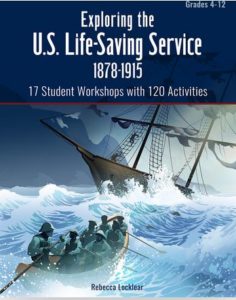 Exploring the U.S. Life-Saving Service is a 117-page ebook and has a variety of different sections/topics (called workshops in the book) which cover different aspects of what the Life Saving Service did. The workshops are categorized by the amount of critical thinking required to succeed in the section. The ones that require more problem-solving are geared for higher age groups, but there are tasks for everybody (grades 4-12). Topics include things like
Exploring the U.S. Life-Saving Service is a 117-page ebook and has a variety of different sections/topics (called workshops in the book) which cover different aspects of what the Life Saving Service did. The workshops are categorized by the amount of critical thinking required to succeed in the section. The ones that require more problem-solving are geared for higher age groups, but there are tasks for everybody (grades 4-12). Topics include things like
- Hunting, fishing, and eating
- Beach patrol
- Rescues with boats
- And even solving scenarios for yourself
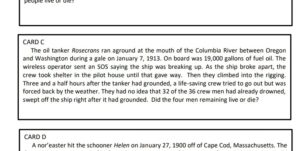 My favorite of the topics given is Rescue Scenarios: Live or Die. The concept behind this assignment is you are given a card (which is a printable within the book) and on it is a limited amount of information about a given situation (the amount you would likely have if you were a real USLSS agent in that situation). You might be given the position of the boat to the shore, the weather conditions, whether your boat is on fire or not, or how many crewman you have. Your objective as the student is to use the information you’re given to solve the situation as best you can and try to save the lives of as many crewmen as possible using random items (around the house) to set up a sort of game board and reenact it and see if your boat would roll, how the waves would effect, how difficult it is to get to the boat in the first place, etc. And then, once you have developed a strategy that you’re comfortable with (through trial and error) you present to your teacher/parent and he/she will decide if your solution is acceptable, and then give you the historical situation and if you got the “answer” right.
My favorite of the topics given is Rescue Scenarios: Live or Die. The concept behind this assignment is you are given a card (which is a printable within the book) and on it is a limited amount of information about a given situation (the amount you would likely have if you were a real USLSS agent in that situation). You might be given the position of the boat to the shore, the weather conditions, whether your boat is on fire or not, or how many crewman you have. Your objective as the student is to use the information you’re given to solve the situation as best you can and try to save the lives of as many crewmen as possible using random items (around the house) to set up a sort of game board and reenact it and see if your boat would roll, how the waves would effect, how difficult it is to get to the boat in the first place, etc. And then, once you have developed a strategy that you’re comfortable with (through trial and error) you present to your teacher/parent and he/she will decide if your solution is acceptable, and then give you the historical situation and if you got the “answer” right.
Sounds like a piece of cake, right? I can tell you from personal experience that it is not as easy as it seems. My first inclination was “Well, if I was in a situation with a flaming ship, I’d want to use divers and cables and hoses.” But in the 1880s, where a lot of these situations came from, those technologies were not yet at their disposal. So solving with today’s technology may not be so hard (but it still is). But with their technology, it becomes near impossible, and for anyone with an analytical mind, this sort of problem solving simulation is fascinating – especially if you love boats too.
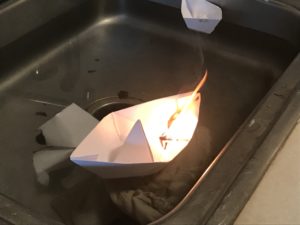 For the lesson I chose in this section, I found one where the scenario was what to do when your boat is on fire. To simulate this, I made a few origami boats and then filled our kitchen sink with water. Once the boats were in the water, I lit them on fire. I figured, and Mom agreed, that I was old enough to use real fire instead of orange crayon. Doing this experiment really gave me a respect for the captains of the boats back then. It was more stressful than I thought it would be dealing with the fire.
For the lesson I chose in this section, I found one where the scenario was what to do when your boat is on fire. To simulate this, I made a few origami boats and then filled our kitchen sink with water. Once the boats were in the water, I lit them on fire. I figured, and Mom agreed, that I was old enough to use real fire instead of orange crayon. Doing this experiment really gave me a respect for the captains of the boats back then. It was more stressful than I thought it would be dealing with the fire.
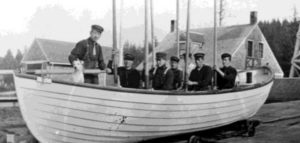 Besides all the activities, there is also a lot of reading about the true history behind the shipwrecks (and other catastrophes) that are on the cards. Many of them take place in the Atlantic Ocean near Cape Cod, which I believe is where the USLSS was based. The reading can be done easily by an older student on their own, or in a group setting as a read-aloud. It is broken into sections by the different jobs of people on the ship. In a group setting, it would be easy to assign students to read aloud, and no one student would have to read a lot aloud. Each section is just one or two paragraphs. The reading is really interesting, especially considering my love of boats. But as much as I love boats, I would not want one of their boats! They are so primitive looking based on the photos in the book to look unsafe – definitely not the kind of thing I would want to sail right into a flaming shipwreck with.
Besides all the activities, there is also a lot of reading about the true history behind the shipwrecks (and other catastrophes) that are on the cards. Many of them take place in the Atlantic Ocean near Cape Cod, which I believe is where the USLSS was based. The reading can be done easily by an older student on their own, or in a group setting as a read-aloud. It is broken into sections by the different jobs of people on the ship. In a group setting, it would be easy to assign students to read aloud, and no one student would have to read a lot aloud. Each section is just one or two paragraphs. The reading is really interesting, especially considering my love of boats. But as much as I love boats, I would not want one of their boats! They are so primitive looking based on the photos in the book to look unsafe – definitely not the kind of thing I would want to sail right into a flaming shipwreck with.
My opinion of Exploring the U.S. Life-Saving Service 1878-1915: 17 Student Workshops with 120 Activities is that it is absolutely amazing. I would definitely recommend this to any study group that has even an inkling of interest in boats or the ocean. It’s generally enjoyable to read and every piece of information is refreshing and it’s topic that you see many books on. Who would have thought there was something before the coast guard?! I would also encourage you to check out Ms. Locklear’s email newsletter (click the link and the signup box is in the right hand sidebar). She sends out seasonal messages with blog posts and book news.
I am so excited to own this book and continue reading and learning from it. I will definitely be doing more of the activities in the future.
Make sure to check out more reviews from our fellow Homeschool Review Crew members over the next couple of days too!
Blessings,
Ballet Boy

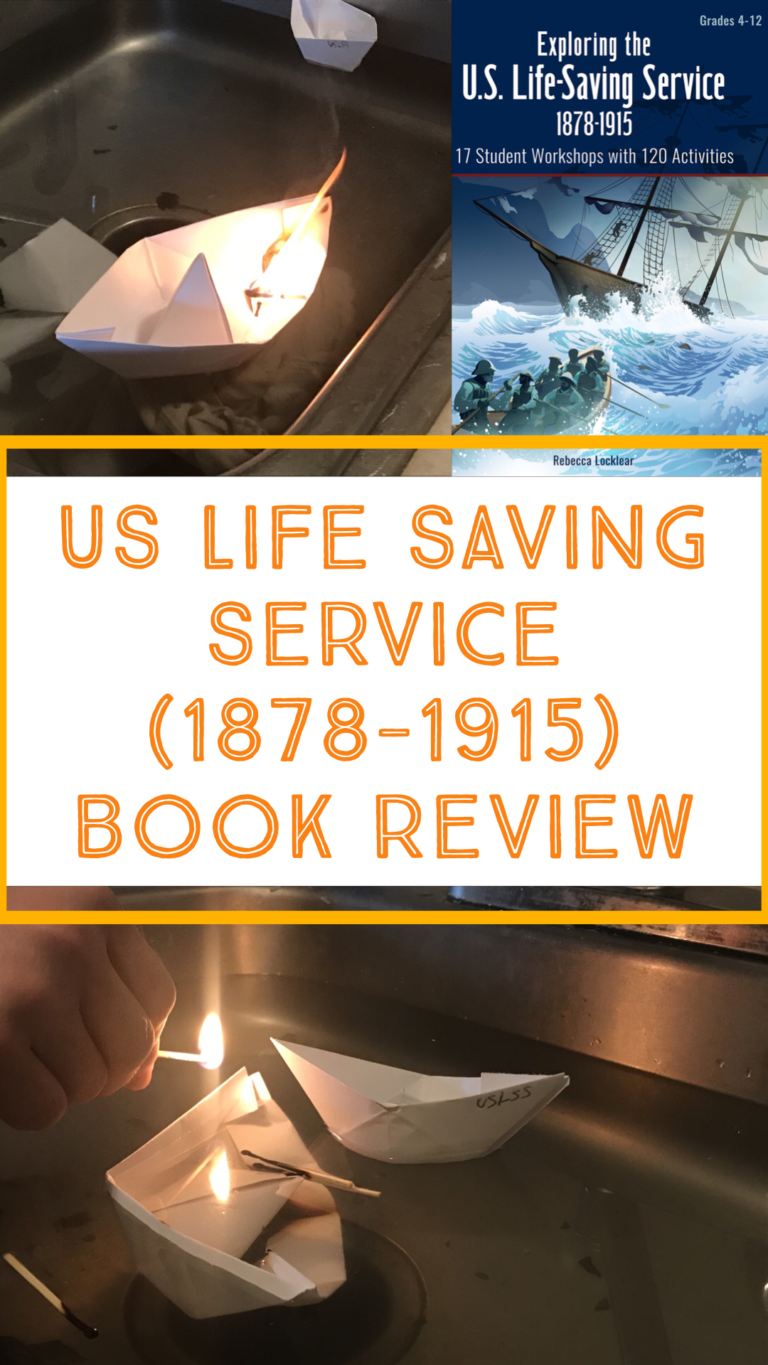
it is an excellent unit study isn’t it?